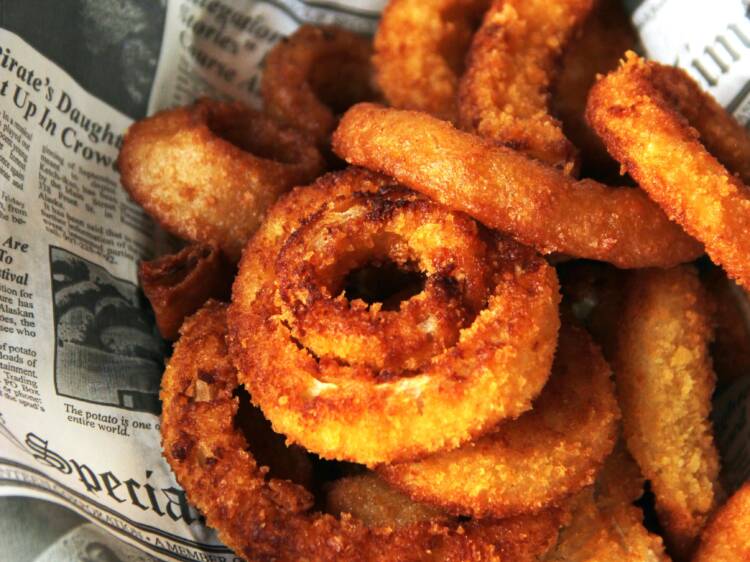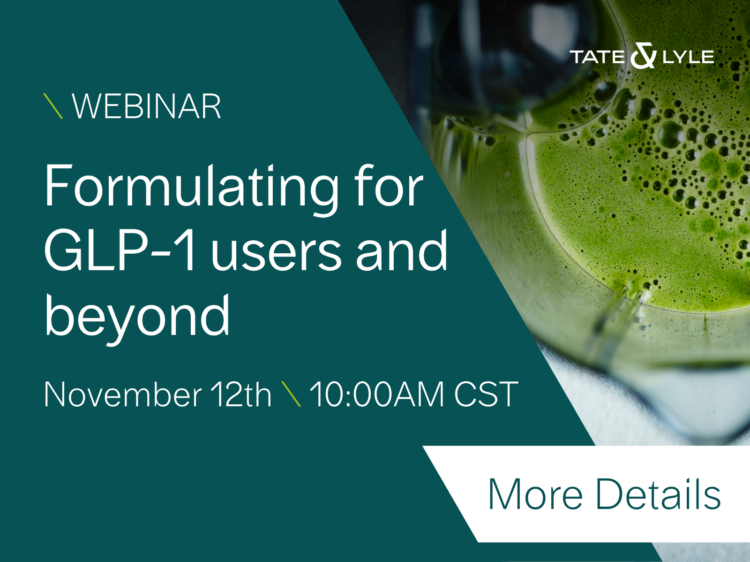Chasing the Perfect Gluten-Free Batter: Niche Product or Premium Upgrade?
by Christine Kerekes, Research Chef
In life, as in cooking, sometimes your path doesn’t lead to the most obvious destination. For example, I studied baking and pastry arts at the Culinary Institute of America. But now, as a research chef, I'm primarily working with the soup, sauces, and dressings team. Paralleling that trajectory, I’m presently doing exciting work with gluten-free flour in commercial batters. What’s the parallel? While it may seem the sole reason to use gluten-free flour is to make a gluten-free product, the opportunities it gives to make a better battered product go far beyond a single niche.
What’s in a batter?
A lot of people are looking for gluten-free products for a variety of reasons. Of course, you have people living with celiac disease who must avoid gluten. Then there are those who don’t have celiac but are gluten-intolerant. Finally, many consumers choose a gluten-free diet simply out of personal preference. It’s a growing market, and it’s here to stay — there will always be a demand for gluten-free products, especially in categories that use flour and traditionally contain gluten.
Unfortunately, they aren’t always easy to find, especially ones that are as good as the original. One reason it’s hard to find delicious-tasting gluten-free products is that you're generally losing out on the overall eating experience — appearance, taste, and texture. For example, a product that’s ordinarily smooth on the palate may be grainy and sandy in a gluten-free formulation.
Most of my experience over the last few years has been with breading and batter for deep-fried coatings. Typically, batters use all-purpose flour, which is, naturally, the primary source of gluten in battered food products. And generally, corn flour is used in combination with all-purpose flour. Those are the two standard flours in a control batter in our test kitchens.
I’ve spent a lot of time working with a tempura-style batter. If you've ever had, for example, tempura shrimp, you know it's not as dense as, say, a chicken tender that’s been breaded and fried. It’s more aerated than other batters and delivers a lighter, crispy, crunchy texture. So what we've done at Tate & Lyle is remove both the corn flour and the all-purpose flour in favor of chickpea flour in tandem with a short grain white rice flour.
With change comes challenge
As you might expect, some challenges come with changing the matrix in a batter formulation to include chickpea flour instead of all-purpose flour.
We’re immediately confronted with a size disparity; the particle size in our chickpea flour is much smaller than all-purpose flour or corn flour. To remove both, we need another flour with a smaller particle size to allow the flour to hydrate more evenly — if you have a small granule and a large granule, they will pick up the water in the formulation differently. This is why we had to pivot to rice flour. As a bonus, with the smaller particle sizes, we use less water to get the same viscosity in our gluten-free batter as the traditional batter possesses.
Next, it impacts the texture. You might be familiar with the role gluten plays in bread or pasta, but it’s very different in batter. The gluten in bread brings structure, trapping gas bubbles and helping to create that particular texture. In batter, it is less about gluten structure and more about the crispiness, the crunch you experience biting into an excellent battered coating. And that, of course, is what we’re after in a gluten-free batter.
Working with different substrates
When it comes to battering food, what you’re applying the batter to makes a big difference in how it adheres. That’s to do with the moisture content and the potential for chemical bonds. For example, fish filets, shrimp, and vegetables have higher moisture content than chicken breasts and tenders. This poses a challenge because it’s harder to get the batter to adhere to substrates with wetter surfaces.
The viscosity required in the batter stays the same no matter the substrate, but the formula makeup will change to improve adherence. We use tapioca dextrin in conjunction with corn starches for adhering functionality and keep the batter attached to the substrate. The tapioca hydrates and forms a gel-like layer that allows the batter to stick, especially to low-moisture substrate like chicken. With something like an onion ring or fish, the goal after frying is to have a crispy, crunchy product that is still moist and juicy inside. To do this, there must be a balance between moisture retained within the substrate and what’s expelled. The trouble is, if the batter is too dense (as it could be if there is too much tapioca dextrin), the gel matrix of the batter will be too thick and trap all the moisture inside, and none can expel. The lack of moisture expelling causes a gummy layer between the substrate and the exterior batter. It also has a negative effect on the batter-to-substrate ratio; thick batters can overwhelm the substrate — for example, a light fish does not need a heavy, dense, thick coating of batter. Since we want some of the batter's moisture to expel, we adjust the tapioca accordingly.
Looking at the better-for-you categories, which is prime real estate for gluten-free claims, we're doing a lot of work in the plant-based space. A plant-based chicken product requires a different matrix than real chicken.
A whole-cut piece of animal protein has an organic shape and texture. In contrast, plant-based meat analogues are formulations of multiple ingredients bound together and extruded to create shapes similar to natural animal proteins. But, the nearly identical, cohesive pieces of plant-based “meat” lack the natural bumps and curves of animal proteins and have more uniform, rigid edges. These machine-made shapes are tricky to get the batter to adhere to. Our formulation, having that higher starch content and optimized viscosity, can ensure your substrate, no matter what shape or size, can pick up the batter evenly and hold on to it during the frying process.
Why gluten-free batters make sense for any application
As I discussed earlier, there are multiple reasons why consumers are after gluten-free products. And, as a foodservice operator or food producer, you may want to have offerings for that demographic. But there are other compelling reasons to switch to a gluten-free batter that have nothing to do with the dietary component.
The Artesa® Chickpea Flour we use has higher starch content compared to all-purpose flour, and starch is a key player in this matrix. Starch is vital for creating that crispy, crunchy texture great batters have. Knowing there is intrinsically more starch right off the bat, we should expect to see a crispier product. And, since in any batter formula, you're going to have starch in there anyways, when we add our high starch flour, we come out with an exceptionally light, airy, crispy, crunchy batter from the fryer. In effect, the starch in the chickpea flour behaves like high amylose starches typically found in commercially available batters. So, because we use our chickpea flour, we don’t have to use high amylose starch; if we need to add more starch, we use corn starch.
In the end, you have a premium product with superior texture. We've conducted sensory panels at Tate & Lyle that show our chickpea flour-based batter outperforms all-purpose flour batter. Even if you leave gluten-free off the table, just in terms of crispy, crunchy texture, the chickpea flour batter is an exceptional product.
We can also see its value through a food-cost savings lens. For foodservice customers, the chickpea flour batter will hold its texture under a heat lamp much better than a standard batter. We've tested onion rings under the heat lamp for 45 minutes. Amazingly, chickpea flour coatings hold their crispy, crunchy texture, almost the same at time zero versus time 45.
For the operator, it means not having to throw out uneaten food from a buffet or holding window every 20 minutes (or whatever your threshold might be) because it’s degrading in quality. That means more food on plates and less in your garbage, and a superior experience for your customers.
Beyond the restaurant, customers will appreciate the enhanced reheatability. We've tested a gluten-free clear-coat batter, the type most often used on French fries. A clear coat has a similar formula to a batter, only considerably thinned until it’s almost like water. We compared clear coats with chickpea flour versus all-purpose flour, and the chickpea flour reheats better on fries in an oven, a standard air fryer, and commercial-grade air impingement ovens. The chickpea flour reheats very well, maintaining that crispy, crunchy texture, even from the fridge or freezer.
It’s well known that we “eat with our eyes,” meaning appearance plays a major role in how we perceive the quality of food. With deep-fried batters, the gold standard is almost literally that — a beautiful golden color out of the frier. Visually comparing two dry flours next to each other, one traditional and our chickpea flour, there's not a huge difference. But once you add water to them and both flours are hydrated, you’ll see a slight yellow hue to the chickpea-based batter, which translates to a beautiful golden brown crispy color after cooking.
At the end of the day, though, taste is the most important factor. All the functionality and cost-savings in the world won’t help if you don’t have a delicious product. There are assumptions with gluten-free products that there has to be a compromise on the flavor because of the chickpea flour. Some people pick up on a beany note, for example. In this situation, however, our chickpea flour has a very clean flavor compared to other chickpea flours we've tasted. And in this fried application, it delivers a boost of umami, a savory sensation that makes you want to keep eating the onion ring or whatever fried deliciousness you choose.
Conclusion: Gluten-free batters are for everyone
Chickpea flour appeals to health-conscious consumers of all kinds; it’s an ingredient that has a health halo to it, and consumers find it appealing. But, many clients I work with are not just targeting gluten-free consumers. For them, it's being able to offer crave-worthy texture — and the amount of time it'll hold that — the value, and the fact that it doesn't carry those stigmas of off-flavors and textures associated with many gluten-free foods.
In short, it simply makes your battered product better and more desirable. A gluten-free batter solution truly can be for anyone. And I’ll bet that’s not where you expected to end up when you started this article.
Watch our Application Demo Video for Gluten-free Batters
ABOUT Artesa®
Artesa® Chickpea Flour is a functional, clean-label chickpea flour using a proprietary protein recovery and milling platform. Some of its unique benefits include its neutral taste and color profile, small particle size, and highly functional gelling properties.
https://www.tateandlyle.com/ingredient/artesa-chickpea-products

